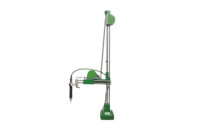Electric vehicles have been a vital element of the green-energy revolution for the past several years. Nonetheless, producing key EV components continues to present great technical challensges for many large and established manufacturers.
Part of the challenge stems from the fact that these components must meet various standards. For example, German manufacturers that use fastening tools to build such components must closely follow VDI/VDE 2862 to ensure reliability.
The Nexans autoelectric Group, based in Floss, Germany, has relied on a DEPRAG manual workstation since 2021 to meet this standard when fastening together EV charging sockets. Founded in 1966, the company has primarily served the automotive industry with cable sets and wiring systems for electric and conventional vehicles, and components for vehicle assistance systems.
“The flexible manual workstation is an ideal and efficient solution,” says Johannes Wagner, process developer at Nexans. “Planning uncertainties can be counteracted, several assembly processes combined, and all of our technical requirements met using DEPRAG’s standard automation components.”
Workstation features include an EC servo screwdriver, a position control portal, a toolbox with multiple color-coded bits and a DEPRAG Processing Unit (DPU) with built-in touch screen. Three sword feeders supply fasteners to the driver via long plastic hoses. Equally important, the workstation easily integrates with the plant’s network and MES systems for optimal data management.
According to Wagner, all screws in the vehicle chargers must be installed according to the VDI standard to ensure consumer safety. This requires Nexans operators to carefully document and monitor all steps of the fastening process.
“[We] guarantee that the right number of the right screws are supplied at the right time,” explains Stefan Rösl, project leader at DEPRAG. “Furthermore, we can ensure that they are supplied to the correct position and assembled using the correct bit.”
Ergonomic guidance of the screwdriver is handled by the position control portal, which also ensures precise positioning of each screw by way of a built-in sensor. After the screw is installed, a sensor in the DPU evaluates the fastener to verify that it meets all installation parameters.
The DPU also notifies the operator when a bit change is required, and continually displays the unit’s operating status on the integrated touch screen. As needed, the operator can watch a step-by-step visual display of the assembly process on the screen.
Wagner says another challenge related to the assembly of charging sockets is keeping track of the different components needed for each country-specific model. Because standards vary across Europe, China, Japan and the USA, the operator needs to slightly modify the workstation with adaptors to properly and efficiently assemble each country-specific charger. Sensors and actuators built into each adaptor automatically connect to the control cabinet for quick and seamless communication.
As for the sword feeders, Nexans selected them to ensure technical cleanliness of each fastener during assembly. Wagner likes that the feeders guarantee gentle, low-friction feeding and separating of the fasteners. A powerful integrated vacuum pump in each feeder removes particles from the screws before they are transported to the workstation and presented for assembly.
For more information on fastening workstations, call 800-433-7724 or visit www.deprag.com.





